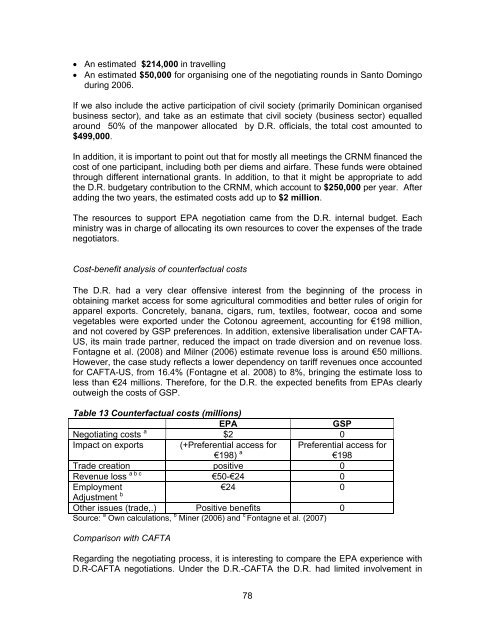EPA Review Annex Documents - DFID
EPA Review Annex Documents - DFID
EPA Review Annex Documents - DFID
Create successful ePaper yourself
Turn your PDF publications into a flip-book with our unique Google optimized e-Paper software.
• An estimated $214,000 in travelling<br />
• An estimated $50,000 for organising one of the negotiating rounds in Santo Domingo<br />
during 2006.<br />
If we also include the active participation of civil society (primarily Dominican organised<br />
business sector), and take as an estimate that civil society (business sector) equalled<br />
around 50% of the manpower allocated by D.R. officials, the total cost amounted to<br />
$499,000.<br />
In addition, it is important to point out that for mostly all meetings the CRNM financed the<br />
cost of one participant, including both per diems and airfare. These funds were obtained<br />
through different international grants. In addition, to that it might be appropriate to add<br />
the D.R. budgetary contribution to the CRNM, which account to $250,000 per year. After<br />
adding the two years, the estimated costs add up to $2 million.<br />
The resources to support <strong>EPA</strong> negotiation came from the D.R. internal budget. Each<br />
ministry was in charge of allocating its own resources to cover the expenses of the trade<br />
negotiators.<br />
Cost-benefit analysis of counterfactual costs<br />
The D.R. had a very clear offensive interest from the beginning of the process in<br />
obtaining market access for some agricultural commodities and better rules of origin for<br />
apparel exports. Concretely, banana, cigars, rum, textiles, footwear, cocoa and some<br />
vegetables were exported under the Cotonou agreement, accounting for €198 million,<br />
and not covered by GSP preferences. In addition, extensive liberalisation under CAFTA-<br />
US, its main trade partner, reduced the impact on trade diversion and on revenue loss.<br />
Fontagne et al. (2008) and Milner (2006) estimate revenue loss is around €50 millions.<br />
However, the case study reflects a lower dependency on tariff revenues once accounted<br />
for CAFTA-US, from 16.4% (Fontagne et al. 2008) to 8%, bringing the estimate loss to<br />
less than €24 millions. Therefore, for the D.R. the expected benefits from <strong>EPA</strong>s clearly<br />
outweigh the costs of GSP.<br />
Table 13 Counterfactual costs (millions)<br />
<strong>EPA</strong> GSP<br />
Negotiating costs a<br />
$2 0<br />
Impact on exports (+Preferential access for<br />
€198) a<br />
Preferential access for<br />
€198<br />
Trade creation<br />
positive 0<br />
a b c<br />
Revenue loss €50-€24 0<br />
Employment<br />
€24 0<br />
Adjustment b<br />
Other issues (trade,.) Positive benefits 0<br />
Source: a Own calculations, b Miner (2006) and c Fontagne et al. (2007)<br />
Comparison with CAFTA<br />
Regarding the negotiating process, it is interesting to compare the <strong>EPA</strong> experience with<br />
D.R-CAFTA negotiations. Under the D.R.-CAFTA the D.R. had limited involvement in<br />
78
















